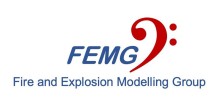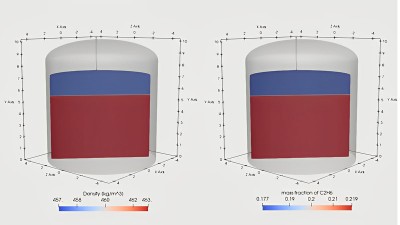

Safety of liquified natural gas
The international commitment to reduce emissions of greenhouse gases has led to a dramatic increase in the use of natural gas. This trend is expected to continue since natural gas is considered a vital ally in the search for a sustainable energy future. As Europe is deficient in natural gas resource, the demands need to be met by growing import in the form of liquefied natural gas.
Overview

The capacity of liquefied natural gas to yield large volumes of gas (a ration of 600:1 at standard temperature and pressure) has made it an extremely important component for the natural gas industry, but also necessitates high safety standards in its handling. This has led to renewed interest in liquefied natural gas safety from the energy security and reliability standpoint.
Substantial development has been carried out within the framework of the in-house version of the OpenFOAM code for consequence analysis related to liquefied natural gas safety. In the final stage of the project and with additional support from other resources, these will be consolidated into a single in-house version to be named as LNGFOAM for predicting:
- Liquefied natural gas pool spread, evaporation and dispersion following a spill on land and water
- Liquefied natural gas rollover
- Flashing cryogenic jets, extension to liquefied natural gas and validation are yet to be carried out
- Vapour cloud formation from liquefied natural gas/other liquid fuel cascade
- Liquefied natural gas pool fires.
Publications
Farhad Nazarpour, Jennifer Wen, Siaka Dembele and Izunna D. Udechukwu, LNG Vapour Cloud Dispersion Modelling and Simulations with OpenFOAM, Chemical Engineering Transactions, Vol. 48, 2016.
Farhad Nazarpour, Izunna D. Udechukwu, Jennifer Wen, Siaka Dembele, LNG Vapour Cloud Dispersion Modelling and Simulations with OpenFOAM, 15th Int. Symp. on Loss Prevention and Safety Promotion in the Process Industries, 5-8 June,2016.
Baopeng Xu, Simon Jallais, Deborah Houssin, Elena Vyazmina, Laurence Bernard and Jennifer X. Wen, Numerical simulations of atmospheric dispersion of large-scale liquid hydrogen releases, Int Conf. on Hydrogen Safety, Edinburgh, September 2021.
Hubert, A., Dembele, S., Denissenko, P., Wen, J., 2019, Predicting Liquefied Natural Gas (LNG) rollovers using Computational Fluid Dynamics, J of Loss Prevention in the Process Industries 62,103922.
Antoine Hubert, Siaka Dembele, Petr Denissenko and Jennifer Wen, Numerical predictions of rollovers in LNG storage tanks using CFD, 72nd FABIG Newsletter.
Antoine Hubert, Siaka Dembele, Petr Denissenko and Jennifer Wen, Numerical predictions of the rollover phenomenon using computational fluid dynamics, Hazards 27, 10-12 May 2017, ICC, Birmingham, UK.
Konstantinos Lyras, Jennifer Wen, Siaka Dembele, D.P. Schmidt, Numerical simulation of subcooled and superheated jets under thermodynamic non-equilibrium, Int. J of Multiphase Flows, vol. 102: 16-28, 2018.
Lyras, K., Dembele, S., Vyazmina, E., Jallais, S. and Wen, J., Numerical simulation of flash-boiling through sharp-edged orifices. J of Computational methods and Experimental measurements, 6(1):176–185, 2018.
Marco Macchi, Jennifer X. Wen, Konstantin Volkov, Ali Heidari and Yongmann Chung, Modelling liquid fuel cascade with OpenFOAM, Process Safety Progress, Article first published online: 14 SEP 2015, DOI: 10.1002/prs.11777.
Changjian Wang, Jennifer X Wen and Zhibin Chen, Simulation of Large-Scale LNG Pool Fires Using FireFOAM, Combustion Science and Technology, 2014, 186(10-11), pp. 1632-1649.
Join us
If you are interested in undertaking a project with us then please contact us to discuss options.

Professor Jennifer Wen
Head of Fire and Explosion Modelling Group